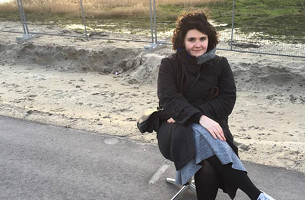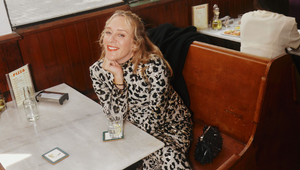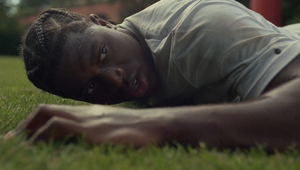
“How Do You Do, Fellow Kids?”

When brands try to pretend they understand youth culture, it often ends in cringe. But they’re not going to stop trying, because the prize for those who get it right is what people in advertising always talk about - being a part of culture, not just on the periphery.
While most agencies will try and keep up to date with what’s cool through simple osmosis - the collective cultural experience of the people who work there - 72andSunny Amsterdam have gone a step further. They’ve got a whole team member dedicated to this aim. Nastassja Bonnabel is their ‘cultural researcher’. With a background in fashion and art direction, it’s her job to make sure their campaigns for clients hit the right cultural notes for the audiences they’re trying to connect with.
LBB’s Alex Reeves caught up with Nastassja to hear more about this role and the sort of person that does it.
LBB> What was your upbringing like. Were you always immersed in culture?
NB> I grew up between Annecy (in the French Alps) and Paris, but I was a kid from the city - don’t try to put me on skis. Apart from the ski slopes, my parents always brought me everywhere, to every exhibition or concert they were going to. I have always been passionate about art and drawing and could spend hours playing with my coloured pencils, making images and creating stories.
LBB> What are your first memories of brands. Was there ever a clue about what you’d end up doing for a job?
NB> I remember asking my dad to buy me the poster of Warhol’s Coca-Cola bottle in a museum shop when I was five. That’s probably my first memory connected to a brand, which is funny because I don't think I had even tried Coca-Cola at that age.
Later, I would watch Culture Pub, the French cult TV-show broadcasting and analysing ads from all over the world. It was fun and moving, but for the 10 year old me it was ‘just’ entertaining. I was very sure about what I wanted to do when I grew up: I “just” wanted to be the next Jean Paul Gaultier.
LBB> So if fashion was your original focus, how did you end up in the world of advertising? And how did you end up with such a unique job title?
NB> After a failed attempt to study Fashion Design, where I was unable to hold a pair of scissors properly, I took a degree in Visual Communication, Graphic Design & Advertising and did a two-year internship at Icon Magazine as an editor/assistant art director.
But the siren calls of fashion beckoned me, and I went on to work for seven years as sales manager and PR for brands like Armani and French Connection.
Then I became a freelancer and decided to help small Parisian businesses with their comms. In 2014, I was recommended (by my husband) to 72andSunny Amsterdam to work on ‘Les Heures Magiques’, a Google social initiative for Parisians, by Parisians.
For this project, 72andSunny Amsterdam needed a hybrid journalist/researcher/strategist/creative who could help with events/production/comms/PR… and it’s how this never-ending-slashed job description became my role, that now, fortunately, fits into just two words: Cultural Researcher.
LBB> What’s your process when it comes to doing cultural research for clients?
NB> I always start a project by creating what I call a “Bible”: a continuous work-in-progress presentation that I share with my team. The backbone of it is a mix of desk research, iconography, a selection of influencers and relevant media that could become potential partners.
One critical chapter of this Bible is the one dedicated to field research: talking to people in real life, with a methodology tailored for each brief - it’s a goldmine. I do my best to have an output as inspiring as the insights in it.
So my days are a mix of deep diving on the Internet, jumping into conversations and a lot of curation.
LBB> What is it about 72andSunny Amsterdam that makes them the kind of agency that employs a cultural researcher?
NB> 72andSunny Amsterdam believes that a good idea can come from anyone, not only professionals with ten years of advertising background. I had never worked in advertising before working here. Tailoring a job for a hybrid freelancer as I was, shows the agency’s willingness to diversify their skill set and, by extension, the creative class within the industry.
72andSunny is a fast-paced agency that strives to make work that creates an impact on culture. The latter isn’t something you can mimic. To make it happen properly, you need to be able to have someone who takes the pulse of what’s happening now. It’s an innovative agency, also in the way they shape their teams.
LBB> What are some examples of ways your work has contributed to recent projects with brands?
NB> For the Smirnoff ‘We’re Open’ campaign that 72andSunny Amsterdam developed last year, I was scouting talent who shared the message of openness and inclusion that the brand stands for.
I found Nadia Tehran and DJ Jeffrey Jewell during a four-month exploration of subcultures and social tensions in 12 different countries.
On adidas, I scan sports culture in key markets to feed the creatives with fresh references and local nuances during the strategic and creative development of two campaigns that you will see in the coming months.
LBB> What is Paris Nord and how did you get started with it?
NB> Paris Nord is a clothing line that Mario Guay, my weirdo lover/husband, and I created in 2013. It’s more than just clothes; it’s a project that speaks about society and our love of Northern Paris. We had this amazing and poetic playground in front of us, and we wanted to celebrate the beauty of it, which isn’t often recognised. A beauty that is younger, rougher, more authentic and as bold, complex and diverse as the inhabitants of this part of the city.
LBB> What do you think it does that people can’t get elsewhere?
NB> I think that our audience likes the unfiltered vision we are sharing, the fact that, for example, we shot our last campaign in small restaurants of the 18th and 19th arrondissements.
Parisians recognised themselves in our brand, and in its anti-nostalgic message. The non-Parisians appreciate the authenticity of it. It’s not the cute picture postcards they are used to seeing.
We all share the thought that the best is just in front of us, not behind. The Paris that we love is not about Sartre, la Nouvelle Vague or the Boulevard Saint Germain. It’s about Mohamed Lamouri (iconic and fantastic raï singer on Line 2 of the Metro), Le 104 and Belleville.
LBB> Does what you do with Paris Nord feed into your work with 72andSunny and vice-versa?
NB> For Paris Nord, we do everything ourselves: of course, we design the clothes and work on the brand, but we are also organise our stock on our kitchen table and prep the orders in our living room and reply to all the emails and comments from our sofa.
I apply this mega holistic vision to my work at 72andSunny. One thing that I love about my role is that my involvement starts at the very beginning of a project, at the early stages of strategy, and continues until the end. Paris Nord helps me keep my feet grounded in reality and go directly to the essential.
On the other hand, I think that 72andSunny is teaching me how to grow an idea, to spot the little details that can become a bigger concept. Also, they’ve taught me how to plug in my pragmatic brain when we have to organise a photoshoot in nine different locations, with nine different models during a Saturday afternoon.
LBB> What cultural areas do you think are key for brands and their agencies to understand right now?
NB> Obviously, and unfortunately, I am not a 16 year old cool kid from London, but I am passionate about understanding youth culture, and discovering the thousand of subcultures they are shaping and taking part of.
I think that the next generation - I like to call them the “Post Gen” - is already challenging how brands are connecting with their audience. For example, they seem to have already heard so many ‘manifestos’ that all they want to see now is proper manifestations. Or their increasing scepticism when it comes to influencers on social media. They know better than anyone how it works, and are questioning the relationship between influencers and brands.
LBB> What sort of brands most benefit from this cultural focus?
NB> I don’t think I know a brand that deliberately wants to be disconnected from culture. So I guess, it will be more and more common and mandatory to have this cultural focus. Especially if a brand wants to connect with the Post Generation, who is expecting genuine interactions and will spot “try hard” behaviour 10 kilometres away.













